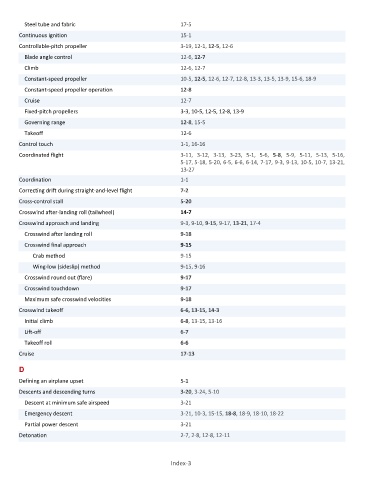Page 394 - Airplane Flying Handbook
P. 394
Steel tube and fabric 17-5
Continuous ignition 15-1
Controllable-pitch propeller 3-19, 12-1, 12-5, 12-6
Blade angle control 12-6, 12-7
Climb 12-6, 12-7
Constant-speed propeller 10-5, 12-5, 12-6, 12-7, 12-8, 13-3, 13-5, 13-9, 15-6, 18-9
Constant-speed propeller operation 12-8
Cruise 12-7
Fixed-pitch propellers 3-3, 10-5, 12-5, 12-8, 13-9
Governing range 12-8, 15-5
Takeoff 12-6
Control touch 1-1, 16-16
Coordinated flight 3-11, 3-12, 3-13, 3-23, 5-1, 5-6, 5-8, 5-9, 5-11, 5-13, 5-16,
5-17, 5-18, 5-20, 6-5, 6-6, 6-14, 7-17, 9-3, 9-13, 10-5, 10-7, 13-21,
13-27
Coordination 1-1
Correcting drift during straight-and-level flight 7-2
Cross-control stall 5-20
Crosswind after-landing roll (tailwheel) 14-7
Crosswind approach and landing 9-3, 9-10, 9-15, 9-17, 13-21, 17-4
Crosswind after landing roll 9-18
Crosswind final approach 9-15
Crab method 9-15
Wing-low (sideslip) method 9-15, 9-16
Crosswind round out (flare) 9-17
Crosswind touchdown 9-17
Maximum safe crosswind velocities 9-18
Crosswind takeoff 6-6, 13-15, 14-3
Initial climb 6-8, 13-15, 13-16
Lift-off 6-7
Takeoff roll 6-6
Cruise 17-13
D
Defining an airplane upset 5-1
Descents and descending turns 3-20, 3-24, 5-10
Descent at minimum safe airspeed 3-21
Emergency descent 3-21, 10-3, 15-15, 18-8, 18-9, 18-10, 18-22
Partial power descent 3-21
Detonation 2-7, 2-8, 12-8, 12-11
Index-3

